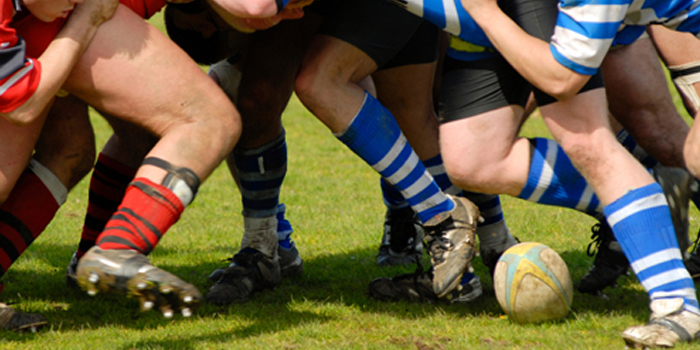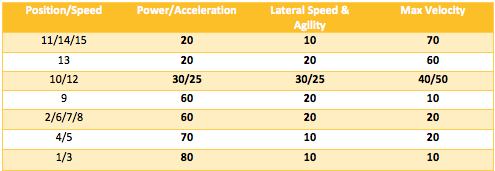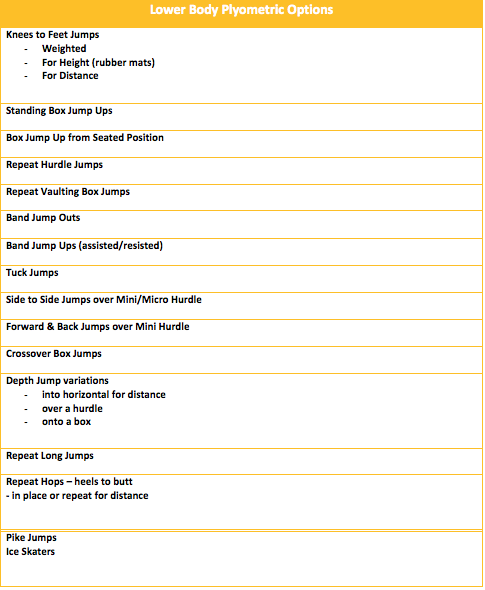
“I feel a need, a need for speed,” as the famous quote from Top Gun goes. The old coaching question “how can I make my team faster,” which is answered with the quip “recruit faster players,” still has a high degree of truth in it, but certain aspects are certainly trainable.
Listening to the likes of Boo Schexnayder and Franz Bosch and having the resources of Jared Deacon and Nick Lumley in nearby offices has taken me back to the trainable aspects of this most important of athletic qualities, especially in the acceleration qualities of speed from 0–30 meters. It has been stated that 0–10 meters is highly correlated with performance in the back squat with two times body weight often quoted as desirable. In the next phase of acceleration from 10–30 meters, it is the power clean standards that are often quoted as most important.
With so many areas of physical development to be considered in team sport preparation, you must prioritize in conversation with your coaching staff and playing staff as to what is most important for each player to develop in order to make them better at the given sport. So this article is specific to rugby, but the transfer to many team sports can't be overlooked in its relevance to other sports preparations as well.
The following is a method that I often use to get an idea of how to program for position. From there, it is individualized. This is open to much discussion and is a living document, but I believe it's a good starting point from which to develop.
Percentage of components in speed performance by position number:
Because time is often limited, especially in-season, I tend to program using the percentages of the above in a one-hour time block. For example, the position of number nine or scrum half will spend, after warm ups, 60 percent of the session in power and acceleration activities, 20 percent in lateral speed and agility and a final 10 percent in maximal velocity drills. In a training session for this position, because the power and acceleration components are so high, it is an excellent idea to include lower body weight training concurrently. An example of a single session for this position is included below.
Speed-Power Session
The warm up will consist of dynamic mobility movements, incorporating lateral speed and agility elements such as the pro agility drill, ladders, mini hurdles, resisted lateral marches, skips and runs and lateral sled drives before starting the main emphasis of the program for this position—power and acceleration.
- Peak power exercise (2–3 reps per set using the Tendo unit or Gymaware to regulate loading based on specific velocities) supersetted with 10-meter sprints (through timing lights if available), 5 sets X 2 reps on each
The peak power movements will include the power clean, power snatch (from floor, hang or blocks), jump squats and trap bar deadlift into shrugs.
- Plyometric exercise choice, 5 reps supersetted with 1 20-meter sled sprint for a total of 5 sets
A listing of potential lower body plyometric options is included below.
- Peak force exercise, 4 sets X 3 reps at less than 85 percent
Peak force movements will include back squats, front squats, box squats, trap bar deadlifts and single-leg leg presses.
Any discussion on velocity-based training would be incomplete without reading the thoughts of Bryan Mann. I urge all readers to revisit his work in this area, specifically the articles "Peak Velocity and Olympic Lifts" and "The Tendo Unit and Its Use in Autoregulation" as well as his ebook Developing Explosive Athletes: Use of Velocity-Based Training in Training Athletes.
Because maximal velocity only accounts for 10 percent of this player’s positional requirements, I may include some flying 30-meter sprints and matched pair sprints over varying distances as part of another session to ensure that this is being attended to and not forgotten in the general programming mix.
Another very important aspect of speed development for team sports athletes is the use of sled training as a special exercise. To quote Nick Lumley, this is “movement pattern specific.” I've often gone outside the athletic parameters in using sleds, where a 10 percent decrement in speed times has been often quoted. The work of N. Kawamori (1) is extremely interesting and relevant to all discussions of loading in resisted sprint training as is the excellent article by Bryan Mann on the same topic.
I've used the following in my sled loading patterns and have had positive responses in improving speed. I use an inverse relationship between distance and load, starting out with 25 percent of a one-rep max back squat load on the sled for 10 meters and decreasing this load by 5 percent for each 10 meters in distance that the player will be running. I'll also contrast between loaded and unloaded sprints at the same distance to reinforce normal (unloaded) running mechanics.
To conclude, I'll include three sessions that I've been using and that you may find useful in your programming:
Session 1 (repeat three times)
- Standing long jump and 15-meter sprint
- 15-meter sprint, start on chest
- Standing triple jump and 15-meter sprint
- Resisted harness, 20 meters
- Long jump (3 times) and 20-meter sprint
- Heavy sled sprint, 20 meters
Session 2 (repeat three times)
- Short bungee
- 10-meter sprint, power skip, 20-meter sprint
- Short bungee
- 10-meter sprint, speed bound, 20-meter sprint
- Short bungee
- 10-meter sprint, zigzag bound, 20-meter sprint
Session 3 (repeat three times)
- Power skip (5 each leg)
- Prowler push with low handles, 20 meters
- Bounds (5 each leg)
- Flying, 30 meters with 10 meters lead in
- Resisted harness release, 10–30 meters
- 20-meter sprint from crouch start
I hope some of these ideas encourage you to reexamine aspects of your speed development program. I look forward to hearing about your results and further discussing aspects of this important area of physical development.
References
- Kawamori N (2009) Sprint acceleration performance in team sports: Biomechanical characteristics and training methods. Perth: Edith Cown University.













MJay@sharks.com.au
I had a questions specifically related to the carry over of gym exercises to field work. Do certain exercises carry over to different specific tasks on the pitch? Would a heavy 1 RM back squat translate to a powerful sprint start, or a power clean translate to more power in top speed? Would the prescribed olympic lifts/squats/plyos prescribed in the full body/lower body strength/power workouts vary between positions? ie. Heavy back squats for props, lighter back squats for backs etc.?
On another note, I have read through your ebook as well, and have programmed my offseason according to those guidelines! For reference I am a tighthead prop. Should my approach to all programming be the metabolic approach, incorporating alot of gym circuits etc? Would those circuits hinder strength and muscle gains in the offseason, and should the beastly circuits etc. be used primarily in pre-season/in season? If you could give any specific recommendations for the TH props you have programmed for in the past it would be much appreciated! My email is ryankotlewski@gmail.com if you prefer that route!
Cheers!
Ryan
As to your second area of questioning, again if you have a metabolic weakness, it is important that this is a priority but I have seen time and time again players actually improve strength by doing a program with circuit work as the main focus, so do not be concerned you will be getting stronger. I continue to use Beastly circuits in season as well, as a top up if a player does not get enough game time and also as a recovery mode with lighter weights as well.
I hope that assists and I will be in contact as well, cheers, ashley
I wish they had shown the World Cup here in the states on a channel people actually get. I don't think the quality of rugby here is going to get better until popularity goes up. For that to happen people are going to have to be able to watch it, so networks are going to have to take the initiative and a little bit of risk that the ratings might not be great, but put it on a bigger channel anyway. Universal is owned by NBC, they couldn't just put the Eagles games on one of the NBC channels?
Another great article to add to the content you've already got out there.
A few quick questions I wanted to shoot by you:
- in the example program, why do you limit peak force work to <85%? Is it to limit fatigue? Or because it could shift the focus of the session from power/acceleration to a more strength development?
- again in the example with max v. work only accounting for 10% of the session for a 9 some flying 30m sprints could be suitable, but what do you do with back 3 athletes who need a greater focus in this area? Simply increase the volume? or chuck some extra work in - if so, what kind of stuff have you found to work well? some sled work (as you talk about after the max v. section)?
If its any easier for you, I'd be happy to chat via email - tombryansnc@gmail.com - I'm sure there are a few more questions that will pop up in future too!
Anyway thanks very much again for all the insights - I've tried incorporating a lot of what you've suggested this season with some great successes, long may it continue...
Tom
Another great article to add to the list of great content you've got out there already.
There are a few questions I want to run by you:
- In the example 9 program you talk about limiting peak force work to <85%, why is this?
is it to try and keep a lid on fatigue? or to ensure that the focus of this session remains power/accell., rather than shift to maximal strength development? or is it simply that you've found this is an appropriate % to use in this population?
- Secondly, you recommend 9s needing ~ 10% max v. work, but what have you done with player groups (predominantly back 3) that require a much higher focus on this area? Have you simply increased the volume of flying 30m's to account for this? or do you add in additional work? If so, what have you found to work well?
If its any easier for you, I'd be happy to talk via email (tombryansnc@gmail.com) - I'd also really value the opportunity to talk as I'm sure there'll be some more questions popping up my end in the near future!
Anyway, again huge thanks for everything - I've been applying a lot of the work you've recommended recently with some great successes, long may it continue!
Hope to speak soon,
Tom
<86% I believe is where most start slowing down so it is primarily just to ensure the players focus on the speed over the weight which has become mush easier now that we use gym aware on many lifts in the gym to monitor speed, as for the max velocity work I just add longer distance high speed running work into the program and now will take the back three out to 60 metres on a regular basis, hope that helps and I will drop you a line on email as well, cheers, ashley